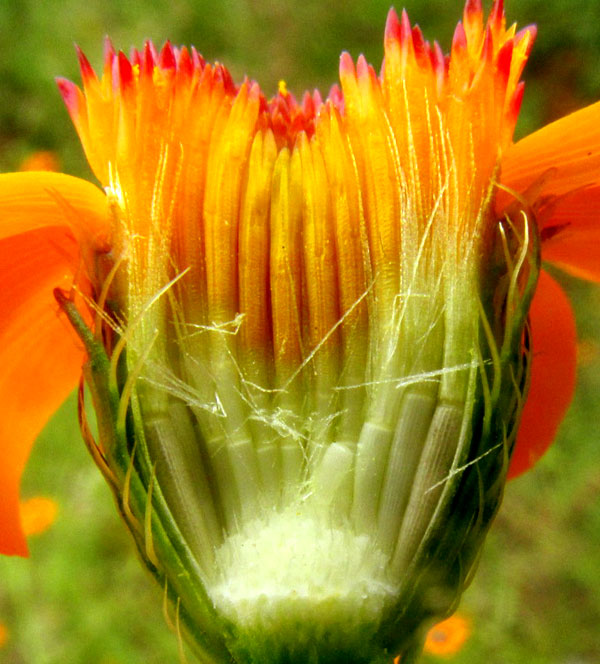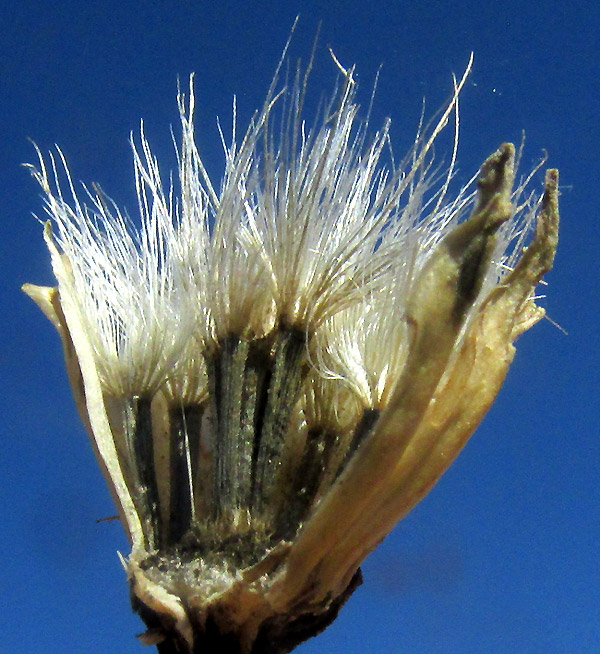Excerpts from Jim Conrad's
Naturalist Newsletter
entry dated October 2, 2022, issued from near Tequisquiapan, elevation about 1,900m (6200 ft), N20.565°, W99.890°, Querétaro state, MÉXICO
DOGWEED

Here during the middle of the rainy season -- albeit a rainy season which came two months late, and has yet to produce much rain -- the landscape is resplendent with broad swaths of yellow-flowered members of the vast Composite or Aster Family, the Asteraceae. These splashes of yellowness are provided by several different species. Among those species, the knee-high one shown above is one of the easiest to distinguish, because its blossoms are tinged with orange, and the blossoms' eyes are dark orange. Also, the leaves are finely divided into narrow lobes.

From the side, it's seen that the flowering heads' stems, the peduncles, thicken at the top, like clubs. Also, notice that leaves immediately below the heads are very finely divided into threadlike sections, while those farther down have broader blades. The green, cuplike involucre below the yellow florets is elegantly covered by finely divided, leafy parts:

Beneath Aster Family flowering heads, one expects a usually-green involucre composed of scale-like bracts, or phyllaries. This head has phyllaries, but they're mostly hidden beneath very finely divided, feathery items known as calyculi. Calyculi are bracts, or modified leaves, which below a flowering head resemble an outer calyx or involucre. The calyculi gradually merge into leaves, and along the stem's lower part the leaves develop flat blades. This feature distinguishes our plant from all other of our landscape's yellow-flowered Aster Family members.
Even if this species' blossoms are among the easiest to recognize, the matter of their species name is much harder to work out. To which tribe and genus does it? A broken-apart head usually provides the main orientation:

Among the most important details revealed above is that among the slender disc florets crowded in the blossom's center, no flattish or scoop-shaped, scale-like palea arise beside the base of each finely ribbed ovary, the future cypsela-type fruit. Also, atop each ovary arise numerous white, very slender, hairlike bristles. The collection of bristles is known as the pappus, and pappus configuration -- when pappi are present -- is one of the most important diagnostic features in the Aster Family. These particular pappus bristles merge with one another at their bases. That's not obvious without magnification, but when using technical features for ID purposes, it must be recognized. It's tricky. Another tricky feature is shown below:

Those are mature cypsela-type fruits. The cypselae of the disc florets are black and topped with parachute-like pappi for wind dispersal. At each side of the line of disc florets there's a ray floret with a cypsela of a different form than the disc florets, with no pappi, and not black. One of the most critical features to notice when identifying Aster Family species is whether all florets are fertile, or if one kind of floret is fertile and the other isn't. Here the disc florets are clearly fertile, but what about the rays? It might seem that the ray florets are sterile, but the experts assure us that are they fertile, but lacking stamens. That's tricky for field workers trying to identify the genus.

The above leaf shows to what degree the filamentous upper leaves develop blades as they descend the stem.
All the above features lead us to ADENOPHYLLUM CANCELLATUM. The genus Adenophyllum is a small one consisting only of 10 species, all endemic just to the US southwest, Mexico and Central America. Members of the genus sometimes are called dogweeds, for no apparent reason.
Adenophyllum cancellatum is endemic just to northern and central Mexico, and is regarded as a common weed of disturbed sites, at elevations from 750-2100m (2400-7000ft).
Dogweeds of the genus Adenophyllum belong to the Aster Family Marigold Tribe, the Tageteae, which places its center of diversity here in the Mexican highlands. The resemblance of dogweeds to marigolds can be noted not only in the orangish flower color but also the very slender cypselae, and the tendency toward finely divided leaves. However, a prime feature of the Marigold Tribe is that the species' leaves normally are dotted with conspicuous glands filled with fragrant oils causing the leaves to issue a powerful musky odor when crunched. Where are our dogweed's glands?
They're described as positioned at the bases of leaf lobes and just below lobe apexes. In the above leaf photo, the white spots surrounded by black tissue appear to be fungal infections. I think the glands must consist of the swollen, darker-green, often elongate zones along the leaf and lobe margins, not nearly as well defined as in marigolds. Once again, our species is tricky.
However, all the trickiness is just in our own heads, a result of the human urge to compartmentalize and simplify. The plant is just being itself, a marvel of evolutionary success having acquired the comfortable status of a common species in a commonly occurring environment.
entry dated December 30, 2023, issued from near Tequisquiapan, elevation about 1,900m (6200 ft), N20.565°, W99.890°, Querétaro state, MÉXICO
DOGWEED DRIED UP


Since the previous entry was made over two years ago, the unusual lack of rain mentioned earlier has become a continuing two-year drought currently described by the North American Drought Monitor as a D3 Extreme Drought. This year's rainy season never developed. When I saw the above leafless but flowering plant in its dried-up condition, I didn't recognize it as a Dogweed; not even when noticing this species' very unusual, feathery calyculi shown at the right. It's interesting to compare those calyculi with the ones seen earlier, which were so large and numerous that they hid the involucre. This species clearly can adapt to a wide range of environmental conditions.

The above photo better shows the structure of the pappi atop the cypsela-type fruits. One reason this species is hard to identify using technical features is that the white "hairs" atop the cypsela, despite their appearance, are not considered simple white hairs. Notice how bunches of hairs unite at their bases. Technical works conceive of these bunches as scales comprising bristles joined at their bases, forming structures like feather dusters with handles. They're scales topped with "basally connate bristles," as the Flora of North America says.
This detail is seen in the mind, not in the object before you. If you don't get it right, you can waste lots of time letting the keys lead you in wrong directions.